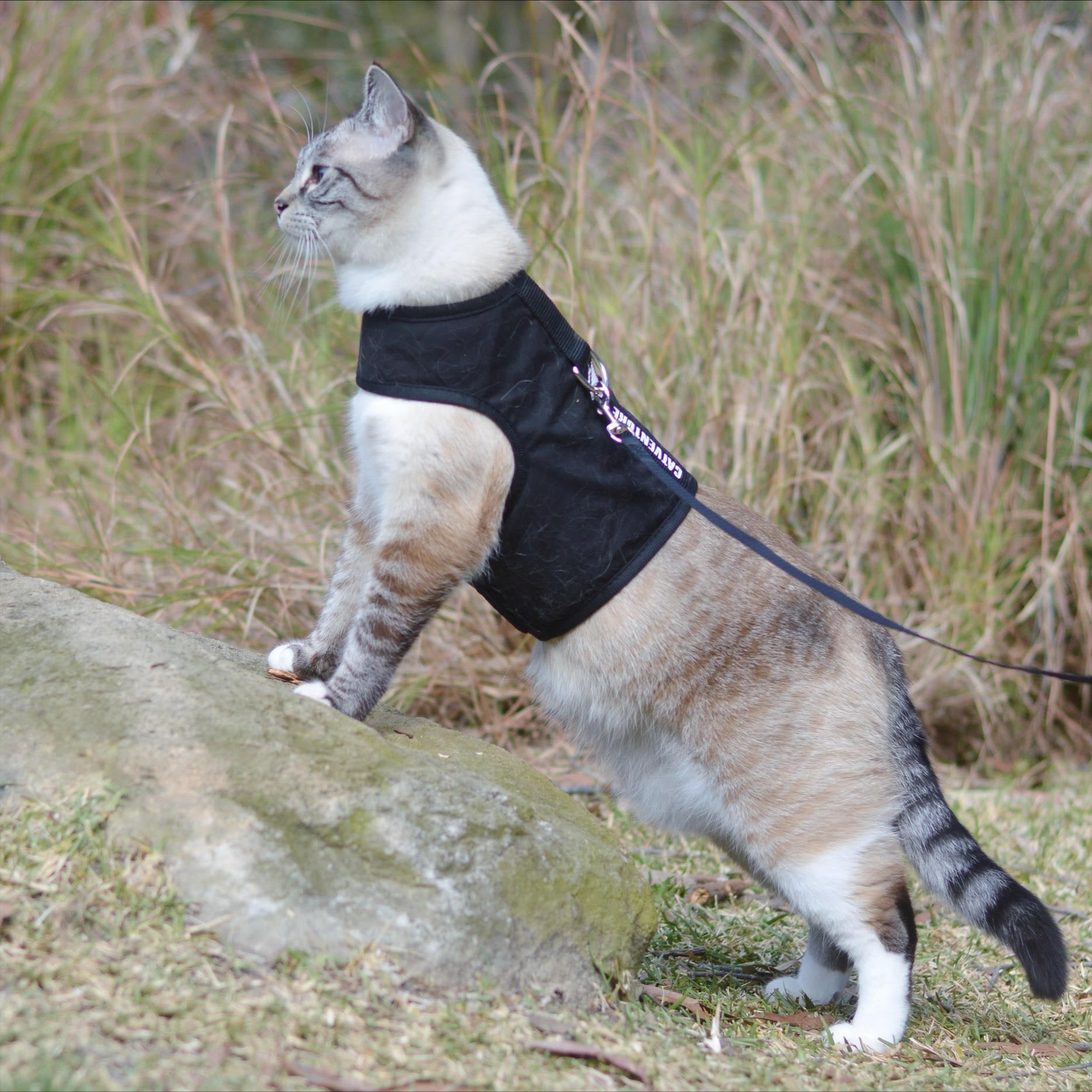Unlock the mysteries of your cat's communication to better understand their needs, emotions, and preferences at home and while exploring the great outdoors in a cat harness.
Cats are mysterious creatures, often leaving their owners perplexed about their feelings, wants, and needs. Understanding your cat's body language and vocalisations is essential to build a strong bond and provide the best possible care. This knowledge is particularly valuable when venturing outdoors with your feline friend in a cat harness. In this comprehensive guide, we'll delve into the secret language of cats, teaching you how to interpret their cues and better comprehend their needs, emotions, and preferences.
Section 1: Decoding Basic Feline Body Language
Tail Movements and Positions:
The tail is a crucial tool for cats to communicate their emotions. Here's a quick breakdown of different tail positions and their meanings:
- Straight up: A sign of happiness and contentment, often accompanied by a slight curl at the tip.
- Puffed up: Indicates fear, agitation, or aggression.
- Tucked under the body: A sign of submission or fear.
- Swishing back and forth: This typically means your cat is irritated or agitated. If the swishing becomes more intense, it may signal impending aggression.
- Slowly wagging: Indicates focus or concentration, usually while stalking prey or a toy.
Ear Positions:
A cat's ears are expressive and can reveal their emotional state. Pay attention to these ear positions and their meanings:
- Forward-facing: Indicates alertness, curiosity, or happiness.
- Slightly turned back: Signifies mild irritation or uncertainty.
- Flattened against the head: This is a sign of fear, anger, or aggression.
Eyes:
Cats use their eyes to communicate a variety of emotions. Keep an eye out for these cues:
- Slow blinking: Often called "cat kisses," slow blinks signify trust and affection.
- Wide-open with dilated pupils: This may indicate excitement, fear, or playfulness, depending on the context.
- Narrowed or slit pupils: This often means your cat is feeling tense or aggressive.
Posture and Body Movements:
A cat's posture and body movements can convey their feelings and intentions. Here are some common signals:
- Arched back with fur standing on end: This is a defensive posture that indicates fear or aggression.
- Lying on their back with paws in the air: While it may appear inviting, this position usually means your cat is feeling defensive and prepared to strike if necessary.
- Rubbing against you or objects: This is a sign of affection and also a way for cats to mark their territory with scent glands in their face.
Section 2: Understanding Feline Vocalisations
Cats communicate using various vocalisations, each with its unique meaning. Here's a guide to some common cat sounds:
- Meow: A versatile sound that can mean anything from a greeting to a request for food or attention. The pitch, duration, and intensity of the meow can help you determine its meaning.
- Purr: Often associated with contentment, purring can also occur when a cat is in pain or anxious. Pay attention to the context and your cat's body language to understand the reason behind their purr.
- Hiss: A clear sign of fear, anger, or aggression, hissing is a warning to stay away.
- Growl: Growling indicates that your cat is upset, frightened, or angry. It's best to give them space and avoid interaction when they growl.
Section 3: Interpreting An Anxious Cat's Body Language and Vocalisations Outdoors
When taking your cat outside on a harness, it's especially important to understand their body language and vocalisations to ensure a safe and enjoyable experience.
- Pay attention to your cat's tail: If your cat's tail is puffed up or swishing back and forth intensely, it might indicate that they feel threatened or scared. In this case, provide comfort and reassurance or consider retreating to a safer location.
- Observe their ears: Ears flattened against the head or turned back can signal fear or irritation. Be prepared to comfort your cat and remove them from any potential stressors.
- Monitor eye signals: Dilated pupils or narrowed eyes may indicate that your cat is experiencing stress or anxiety. Assess the situation and provide a calming presence or remove them from the source of their unease.
- Listen for vocal cues: If your cat hisses or growls while on a harness, it's essential to take their warning seriously and address the situation accordingly.
Section 4: Recognising Happy Cat Body Language and Vocalisations Outdoors
When taking your cat outside on a harness, it's equally crucial to recognise the signs of happiness and contentment to ensure their well-being and make the most of the outdoor experience.
- Watch their tail: A relaxed, gently swaying tail or a tail held high with a slight curve at the tip indicates a happy and confident cat. Enjoy the moment and continue exploring at their pace.
- Pay attention to their ears: Forward-facing, alert ears signal that your cat is engaged and curious about their surroundings. Encourage their curiosity and let them explore the environment.
- Observe their eyes: Soft, relaxed eyes with slow blinking show that your cat feels safe and comfortable outdoors. Maintain a calm and soothing presence to reinforce their trust in you.
- Listen for vocal cues: Purring, trills, or chirps are signs that your cat is content and enjoying their time outside. Reinforce these positive emotions by talking to them in a gentle, reassuring tone.
Section 5: How to Extend Your Cat's Life and Enhance Their Outdoor Experiences
By understanding your cat's body language and vocalisations, you can take steps to prolong their life and create enjoyable outdoor experiences. Here are some tips:
- Provide a healthy diet and regular exercise: A balanced diet and exercise regimen can help prevent obesity and related health issues. Exploring the outdoors on a harness is an excellent way for indoor cats to stay active and mentally stimulated.
- Keep your cat up-to-date on vaccinations and preventative care: Regular veterinary check-ups and vaccinations can help protect your cat from various diseases and health issues.
- Create a stimulating indoor environment: Providing your cat with toys, scratching posts, and other enrichment activities can keep them mentally and physically engaged, reducing stress and promoting overall well-being.
- Use a cat harness for safe outdoor adventures: A well-fitted cat harness allows your feline friend to safely explore the outdoors, reducing the risks associated with roaming freely.
Understanding the secret language of cats is crucial for any cat owner looking to strengthen the bond with their feline companion. By decoding your cat's body language and vocalisations, you can better meet their needs, emotions, and preferences, both at home and during outdoor excursions in a cat harness. Armed with this knowledge, you can ensure a happier, healthier, and more fulfilling life for your beloved pet.










